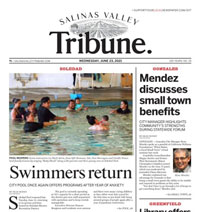SALINAS VALLEY — Caltrans District 5 and Transportation Agency for Monterey County (TAMC) staff recently presented an update on efforts to implement an adaptive signal control pilot project in the Scenic State Route 68 Corridor.
Last October, the TAMC Board of Directors allocated $500,000 in regional Measure X funds toward the purchase and installation of adaptive (also known as artificial intelligence, or AI) signal controls as a pilot project at all nine signalized intersections along State Route 68, linking the Salinas Valley to the Monterey Peninsula.
Adaptive signal control technology adjusts the timing of red, yellow and green lights to accommodate changing traffic patterns and ease traffic congestion. Unlike traditional traffic signals, which operate on fixed timings, adaptive signals use real-time data from sensors and cameras to optimize traffic flow.
“This technology is particularly beneficial during peak travel times, incidents and special events when traffic volumes can vary unexpectedly. Reduced congestion can also reduce collision rates,” according to TAMC.
The adaptive signal operations are expected to serve as an interim solution, complementing the roundabout intersections identified as long-term improvements for the Scenic State Route 68 Corridor.
“Staff have identified potential funding options for the first phase of the roundabout projects, but most intersections along the corridor are expected to remain signalized for the foreseeable future,” stated TAMC.
During its March meeting, the TAMC Board engaged in a comprehensive discussion to assess the phased approach recommended by staff to use the allocated funding to purchase and install adaptive signal equipment at four intersections located at the eastern end of the corridor, rather than installing the AI signals at the nine intersections along the entire corridor.
At the conclusion, the Board voted to authorize up to $1.2 million to purchase and install adaptive signal equipment at nine signalized intersections on State Route 68 — between Toro Park and Highway 1 — over the five-year life cycle of the project; and to receive a report back on the results after the initial installation.














